Welcome to the Euroregion Elbe/Labe!
News
The longest chairlift in the Czech Republic is being renovated
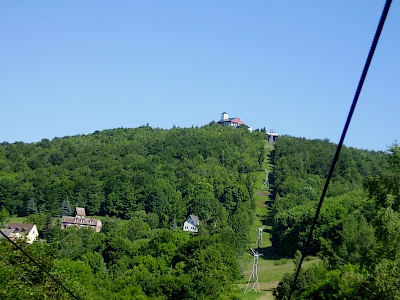
The chairlift from Krupka (Graupen) to the summit of Komáří hůrka (Mückenberg) on the ridge of the Eastern Ore Mountains will be renovated over the next 12 months. The aim of the renovation is to modernize the mountain and valley stations as well as the outdoor facilities while preserving or even restoring the historical character. "We want the chairlift to return to its origins. For example, there used to be lamps at the valley station on the terrace, which we want to reinstall," lift manager Marek Ferenc told the daily newspaper "Mladá fronta Dnes". The lift went into operation in 1952.
Important for all fans of the chairlift: the refurbishment will be carried out while the lift is in operation. Apart from regular maintenance, which is carried out several times a year, the lift can be used with restrictions. These are mainly to be expected at the access points to the lift, not on the lift itself. The downtimes of the lift caused by the renovation should be kept to a minimum. This should be the case in March/April next year, when the floors will be renovated and the lift will inevitably have to be shut down.
There are plans to renovate the façade of the valley station and replace the windows and doors. The snack bar will be refurbished and the toilets renovated. In addition, the exhibition on the history and operation of the chairlift will be expanded. This is open to the public.
Repairs and partial thermal insulation are carried out at the mountain station. The drinking water and waste water supply is renewed and the heat supply is converted to a heat pump. A new workshop is being built for the maintenance of the lift seats.
With a length of 2,348 meters, the chairlift is not only the longest lift in the Czech Republic without an intermediate station, according to the operators, but also in the whole of Central Europe. The lift has been a national cultural monument in the Czech Republic since 2013 and has had the status of a historic chairlift since 2022. Following the modernization of the chairlift to the Schneekoppe, it is now also the oldest of its kind, which still functions as it did when it started operating in 1952.
First lynx offspring in the Ore Mountains
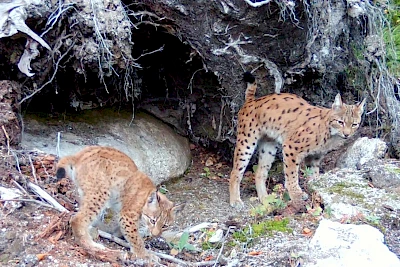
For the first time in almost 300 years, a lynx pair has reproduced in the Ore Mountains. According to the Saxon State Office for the Environment, Agriculture and Geology (LfULG), the lynxes Alva (female) and Chapo (male) released last year are the parent animals. Both were released into the wild near Eibenstock in 2024 as part of the ReLynx project to reintroduce these wild cats. According to GPS data, they spent three days together in Alva's territory at the beginning of April. They have now turned into two cubs, which were "caught" by a photo trap at the beginning of the fall. The pregnancy of a female lynx usually lasts 10 weeks. This means that the cubs must have been born in June.
The wolves have also reported offspring again. In the Schluckenauer Zipfel in northern Bohemia alone, wolf experts counted at least 14 cubs on the basis of photo traps. But there may already be more. The wolves have also reintroduced themselves, but probably through immigration from Poland. According to monitoring, their development is going very well. There are now five packs in the Schluckenauer Zipfels region alone. The wolf territory also extends into neighboring Saxony.
Due to the vastness of the Ore Mountains, it is not possible to provide such precise information. A total of seven wolf packs have been confirmed there. Three of them are certain to have offspring this year.
Government helps problem district in Šluknov
The Czech government has approved an aid package worth almost 200 million for the small town of Šluknov in northern Bohemia. The town wants to use the money to buy 14 prefabricated buildings in a housing estate on the south-eastern outskirts of the town. The deal will cost a total of 285 million crowns (11.7 million euros). Šluknov is paying 25 million crowns out of its own pocket, while the Ústí district is contributing a further 60 million crowns.
After taking over the houses, the city intends to demolish a small part in very poor condition and renovate the others. The background to this major project, which is unique in the Czech Republic to date, is the unusually high rate of residents dependent on social welfare. According to the state agency for social integration, almost all of the 1,500 residents are affected. The aim of the joint project is to reduce this rate to 20 percent. The renovation of the houses is to be accompanied by intensive social work, support in finding work, educational projects and debt relief advice. The municipality is also to receive support from the state in this area. The majority of the current residents will be able to continue living in the prefabricated housing estate, while apartments in the region will be found for a small proportion. A further influx of socially disadvantaged people is to be stopped.
The funding commitment was made on Wednesday by the current government, led by Prime Minister Petr Fiala, after a year of intensive preparations and negotiations with the state, district and municipality. The opposition parties were also involved, which is why the mayor of Šluknov, Tomáš Kolonečný, assumes that the future government will also continue to support the project.
Stores remain open for the holiday
Monday marks the Day of Struggle for Freedom and Democracy in the Czech Republic. On November 17, 36 years ago, thousands of students and citizens demonstrated for freedom and democracy in Prague. The officially unauthorized assembly was brutally dispersed by armed units. It was seen as the beginning of the Velvet Revolution in what was then Czechoslovakia.
Although the larger stores in the Czech Republic remain closed on many public holidays, November 17 is not one of them. All stores therefore remain open. Only museums are closed on Mondays, as usual.
(This is an automatic translation by DeepL Translator.)
Parliament elects right-winger as president
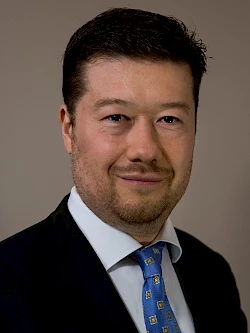
The Czech parliament has elected Tomio Okamura as its president at its first session. The leader of the far-right party Svoboda a přímá Demokrace (Freedom and Direct Democracy) was elected with the votes of the future governing parties ANO and Autofahrer as well as his own party. Okamura, who is of Japanese descent, regularly rails against foreigners, minorities and political opponents. His choice of words is often racist and xenophobic, and he calls for the Czech Republic to leave the EU and NATO in the long term.
His election is a deal between the future governing parties. Okamura deliberately did not want a ministerial post where he would have to take on responsibility, but was aiming for the prestigious post of Speaker of Parliament. Okamura had deliberately trampled on parliamentary conventions in the past. His party had even lost significant support in the elections. However, as it is needed for the government, the deal was made. In addition, both the likely future Prime Minister Andrej Babiš and Okamura are threatened with legal proceedings. In order to ensure that their immunity as MPs is not revoked, both are dependent on cooperation.
As one of his first official acts, Okamura had the Ukrainian flag removed from parliament. The President of Parliament is nominally the third highest office in the Czech state after the President of the Republic and the President of the Senate.
Czech government resigns
The government of Prime Minister Petr Fiala has submitted its resignation to President Petr Pavel and received its resignation papers. However, the ministers will remain in office on a temporary basis until the new government is formed. The future government consisting of ANO, motorists and SPD adopted its government program this week.
New memorial plaque for Karl May

The writer and spiritual father of Winnetou and Old Shatterhand, Karl May, has been honored with a memorial plaque in Chomutov. The plaque was unveiled at the former Hotel Scherber in Chelčický Street. May was visiting friends here in 1897. He came from his home town of Hohenstein-Ernstthal on the other side of the Ore Mountains. Karl May was and still is very popular in the Czech Republic. There has long been a May street in Ústí nad Labem, near a hotel where he stayed for a while and found inspiration for his works near the Schreckenstein.
If you would like to receive our weekly review regularly in your email inbox, sign up for our newsletter.
To the newsletter registration
(This is an automatic translation by DeepL Translator.)
Elbfähre startet endlich im November
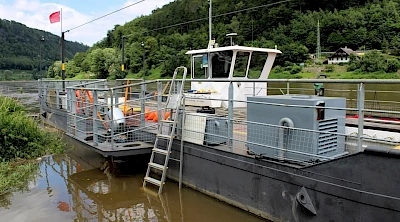
Ursprünglich sollte die Elbfähre zwischen dem Dorf Dolní Žleb (Niedergrund) und der Staatsstraße 62 zwischen Děčín und Hřensko schon im Oktober wieder starten. Nun hat es doch etwas länger gedauert. Nach über einjähriger Zwangspause nimmt die Fähre nun an diesem Samstag (1. November) wieder Fahrt auf. Der neue Betreiber der Gierseilfähre setzt täglich von 8-18 Uhr über. Zwischen 12 und 13 Uhr ist Mittagspause. Lediglich bei Hoch- oder Niedrigwasser wird der Fährbetrieb ausgesetzt. Das soll künftig durch ein Fähnchen sichtbar sein. Weht die tschechische Nationalfahne, ist die Fähre in Betrieb, weht eine rote Fahne, ist kein Fährbetrieb möglich. Man soll den Fährmann auch durch eine Klingel herüberrufen können. Angetrunkene Personen können übrigens von der Mitreise mit der Fähre ausgeschlossen werden.
Der Fährbetrieb erleichtert den Menschen, die in Dolní Žleb leben, die Reisemöglichkeiten. Mit der nächsten Stadt Děčín ist das letzte Dörfchen am linken Elbufer auf tschechischem Staatsgebiet nur über die Eisenbahn sowie eine enge Straße verbunden, die schon bei leichtem Hochwasser gesperrt werden muss. Aber auch Touristen sind eifrige Nutzer der Fähre.
Für eine Überfahrt zahlen Erwachsene ab 15 Jahre 30 Kronen (1,25 Euro), Kinder bis einschließlich 14 Jahren zahlen nur die Hälfte. Die Querung mit dem Fahrrad kostet 50 Kronen (2,10 Euro) und mit dem Auto 100 Kronen (4,20 Euro).
Museum Varnsdorf wird saniert
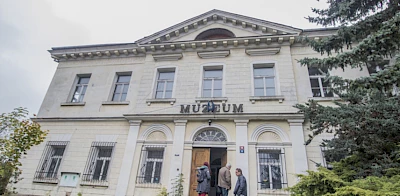
Die Sanierung war überfällig. Seit Mitte Oktober wird am Museum in Varnsdorf gearbeitet. Im Zuge der Sanierung erhält der Hof des Museumsgebäudes eine Überdachung. Der Raum darunter wird künftig der zentrale Ort, an dem Kulturveranstaltungen stattfinden können. Außerdem erhält das Gebäude einen Aufzug, damit alle Etagen barrierefrei zugänglich sind. Weiter werden die Toiletten saniert und der Eingangsbereich. Auch der Bereich außerhalb des Museums verändert sich. Erneuert werden Fußwege, Grünpflanzen sowie Eingangstreppe. Das Museum ist für die Zeit der Sanierung in den Kinder- und Musikbereich der Stadtbibliothek gezogen. Die Sanierung soll im Herbst 2027 abgeschlossen sein.
Das Museum Varnsdorf ist eine Zweigstelle des Gebietsmuseums in Děčín, das übrigens auch gerade saniert wird.
Das Museum in Varnsdorf entstand 1902, musste allerdings oft umziehen, ehe es in den Jahren 2009/2010 in das Gebäude zog, das nun saniert wird. Zur Sammlung des Museums gehören Exponate aus der Geschichte der Textilproduktion, wertvolle koptische Stoffe sowie ein Teil des Nachlasses der sorbisch-tschechischen bildenden Künstlerin und Werbegestalterin Hanka Krawcec.
EU finanziert Batteriezüge
Spätestens ab 2032 sollen auf drei Regionalstrecken des Bezirks Ústí Batterie betriebene Züge eingesetzt werden. Dafür hat der Bezirk Ústí fast 2 Milliarden Kronen (83 Millionen Euro) aus dem Programm TRANSGov zugesprochen bekommen. Das Vorhaben betrifft die Strecken Osek-Most-Louny-Rakovník, Žatec-Louny-Lovosice-Ústí nad Labem sowie Ústí nad Labem-Děčín-Česká Lípa-Liberec, also auch zwei, die in die Nachbarbezirke Mittelböhmen und Liberec reichen.
Die Fördermittel decken 70 Prozent der Gesamtkosten. Der Bezirk plant nun eine Ausschreibung für die Lieferung der Züge.
Tschechisch-Deutsche Kulturtage eröffnet

Im Festspielhaus Hellerau wurden am Donnerstagabend die 27. Tschechisch-Deutschen Kulturtage feierlich eröffnet. Gut 400 Gäste erlebten im Europäischen Zentrum der Künste eine mitreißende Vorstellung des Prager Orchesters für zeitgenössische Musik BERG und der ebenfalls aus Prag stammenden Tanzkompanie 420PEOPLE. Sie führten das Stück INspiraCe des Komponisten Tomáš Reindl in einer Choreographie von Sylva Šafková auf.
Zuvor hatten die Präsidentin der Euroregion und Kulturbürgermeisterin der Landeshauptstadt Dresden Annekatrin Klepsch und der frühere Botschafter der Tschechischen Republik in Deutschland und heutige Direktor der Abteilung Mitteleuropa im tschechischen Außenministerium Tomáš Kafka in zwei bemerkenswerten Reden die Bedeutung der Kultur und Meinungsfreiheit in der Demokratie und der grenzübergreifenden Zusammenarbeit gewürdigt.
Bis zum 16. November finden auf beiden Seiten der Grenze, in Dresden und Ústí nad Labem, sowie in weiteren Kommunen über 100 Veranstaltungen fast aller Genres in verschiedensten Formaten statt. Einen Überblick über das vollständige Programm der Tschechisch-Deutschen Kulturtage findet sich auf der Webseite des Festivals.
All news you'll find here.
Next events
More events you find here.
